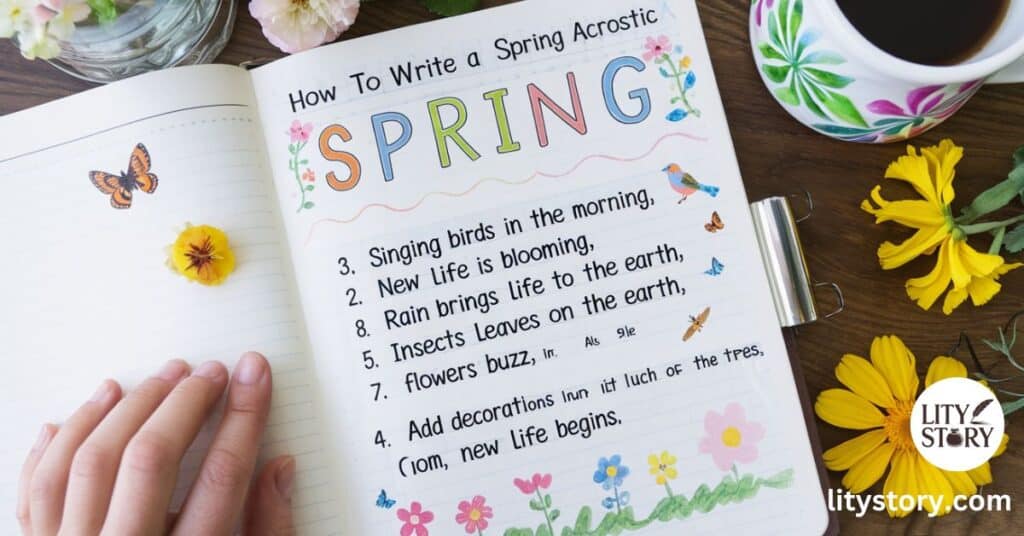Spring is a season that captivates our senses. As the cold of winter fades away, we’re met with vibrant flowers, rejuvenating spirit, and an awakening nature. One of the most poetic ways to celebrate this transformative power of the season is through spring acrostic poems. These poems allow us to explore the beauty of spring in a creative and structured form, weaving together the delicate dance of nature and its visual splendor with each letter.
In this comprehensive guide, we’ll delve deep into the art of writing spring acrostic poems, offer examples, and provide insights on how to bring the essence of this magical season to life in your writing. Along the way, we’ll explore the poetic expression of the season, how it mirrors the natural rebirth and vibrant energy of spring, and inspire your own creations. Let’s dive into the beauty of springtime verses.
What Are Spring Acrostic Poems?

An acrostic poem is a poetic form where the first letter of each line spells out a word, typically the theme or subject of the poem. In the case of spring acrostic poems, the word “SPRING” might serve as the foundation, with each line painting a picture of the season’s revival. This structure allows poets to express complex ideas about nature’s rebirth, the rejuvenating spirit of the season, and the vibrant flowers and colors that come with it.
Why Is Spring a Popular Theme for Acrostic Poems?
Spring symbolizes renewal energy, rebirth, and the cycle of life returning after winter. It’s a season of hope, vibrant energy, and melodic nature. These powerful themes lend themselves beautifully to acrostic poems, allowing writers to capture the essence of spring’s awakening nature with brevity and creativity.
By using specific imagery like colorful blooms, gentle breeze, and the transformative power of the season, spring acrostic poems become a snapshot of the beauty, growth, and visual splendor that spring brings.
Poem Example: “SPRING”
Sunlight dances through the trees,
Petals bloom, kissed by the breeze,
Rebirth is felt in every seed,
In every leaf, in every need,
Nature’s song begins to sing,
Gentle winds announce the Spring.
What Makes a Good Spring Acrostic Poem?

Crafting a great spring acrostic poem isn’t just about spelling out a word with each line—it’s about capturing the spirit of spring in a way that feels organic and emotionally resonant. The key is to blend imagery, emotion, and creativity.
1. Imagery and Nature Themes
A strong spring acrostic poem uses vivid descriptions that bring seasonal poetry to life. Think about the sights, smells, and sounds of spring. Incorporate elements like the vibrant flowers, the sound of birds returning, or the feel of a gentle breeze on your skin.
- Examples of Spring Imagery:
- Blossoms and Blooms: Colorful blooms like tulips and daffodils symbolize life returning after winter’s dormancy.
- Gentle Winds: The spring zephyr, a mild and refreshing wind, ushers in the season of change.
- Wildlife: Birds chirping, insects buzzing, and animals emerging from hibernation embody the energy of spring.
2. Emotion and Tone
Spring is not just a visual experience; it’s emotional as well. Rejuvenating spirit, hope, and renewal are strong themes in any spring poem. By tapping into these feelings, you make your poem relatable to readers.
- Positive Emotions: Spring is often associated with joy, hope, and relief after the harshness of winter. Make sure these emotions are reflected in your poem.
Poem Example: “BLOSSOM”
Buds appear on trees anew,
Life returns with skies of blue,
Over fields, bright flowers grow,
Soft winds through the gardens blow,
Spring’s sweet song fills the air,
Offering peace beyond compare,
Melodic nature sings in tune.
How to Write a Spring Acrostic Poem: Step-by-Step Guide

Writing an acrostic poem is both simple and creatively freeing. With a word in mind, each line begins with a letter from that word, but the content can be as varied and descriptive as you want it to be. Here’s a step-by-step guide to crafting a spring acrostic poem.
Step 1: Choose a Spring-Related Word
Select a word that embodies the essence of spring. Popular choices include “SPRING,” “BLOOM,” “GROWTH,” or even more descriptive words like “VIBRANT” or “AWAKENING.”
Step 2: Brainstorm Themes and Imagery
Think about the themes and images you associate with spring: vibrant flowers, rebirth spring, colorful blooms, melodic nature, etc. Write down descriptive words or phrases next to each letter of your chosen word.
Step 3: Write Each Line with Intention
For each letter of your word, create a line that reflects your theme or image. Use poetic devices like alliteration, metaphors, or similes to make your poem more engaging.
Step 4: Edit and Refine
Once you have your poem, read it aloud. Does it flow naturally? Does it capture the season’s revival and imagery of spring? Refine each line for clarity and emotional impact.
Poem Example: “GROWTH”
Green shoots rise through the earth,
Rain nourishes their newfound birth,
Overhead, the skies are clear,
Warming winds are drawing near,
Trees awaken, birds take wing,
Hints of summer in the Spring.
Examples of Spring Acrostic Poems
To inspire your creativity, here are a few more examples of spring acrostic poems. Each one captures different aspects of the season, from the vibrant energy of nature to the quiet, reflective beauty of seasonal rebirth.
Poem Example: “AWAKENING”
All around, the world is new,
Waking from the morning dew,
All the flowers start to bloom,
Kindness fills the air with room,
Every tree begins to sprout,
Nature’s beauty all about,
In the breeze, I feel the Spring,
Nesting birds begin to sing,
Gentle moments, joy they bring.
Poem Example: “BREEZE”
Blossoms sway with every gust,
Radiant skies we learn to trust,
Every leaf begins to turn,
Each moment, more for us to learn,
Zephyrs softly call the day,
Early Spring is on display.
Inspiration for Spring Acrostic Poems

Inspiration for writing spring acrostic poems can come from many places. Here are a few ideas to help you tap into the creative energy of spring.
1. Observe the World Around You
Take a walk in nature. Feel the gentle breeze, listen to the melodic sounds of birds, and observe the vibrant flowers in bloom. Each sensory experience can become a line in your poem.
2. Reflect on Personal Experiences
Think about what spring means to you personally. Have you experienced a rebirth spring, a personal renewal? Use those memories to shape your poem.
3. Use Seasonal Words
Create a list of words that reflect the beauty and visual splendor of spring. Words like bloom, renewal, awakening nature, and gentle breeze are rich starting points for your poem.
| Spring Words | Meaning in Poetry |
| Vibrant | Represents life and energy in spring |
| Rebirth | Symbolizes renewal and growth |
| Awakening | Represents the start of something new |
| Breeze | A metaphor for gentle change |
Why Write Acrostic Poems About Spring?

Writing spring acrostic poems isn’t just a creative exercise—it’s a way to connect more deeply with the world around us. Spring represents the rebirth of nature, the return of life, and the transformative power of the seasons.
The Emotional Impact
Writing about spring allows us to reflect on our own experiences of renewal, change, and hope. It’s a reminder that life is cyclical and that beauty returns even after the harshest winters. Through poetry,
we can capture these feelings in a way that speaks to both ourselves and our readers.
Acrostic Poetry in Education: Teaching Kids About Spring
Teaching kids to write acrostic poems is a fun and engaging way to introduce them to poetry. Because of their simple structure, even young children can create spring acrostic poems using words that describe their favorite things about the season.
Activity Ideas for Kids:
- Nature Walks: Take children on a walk through a garden or park, where they can observe the vibrant energy of spring. Have them write down words or draw pictures of what they see.
- Classroom Projects: Create a classroom acrostic poem, where each student contributes one line that starts with a letter of the word “SPRING.”
- Seasonal Crafts: After writing their poems, children can create a visual representation of their poem using colorful blooms, leaves, and other natural materials from spring.
| Teaching Tip | Benefit |
| Nature Walks | Encourages observation and connection to nature |
| Group Poems | Builds teamwork and creativity among students |
| Visual Projects | Helps students link their poetry to visual, tangible elements of spring |
Poem Example: “FLOWER” (For Kids)
Flowers bloom in every hue,
Leaves grow bright with morning dew,
Over hills, the grass turns green,
Wind blows softly, calm and clean,
Everything begins to sing,
Ready now for a brand new spring.
Tips for Enhancing Your Spring Acrostic Poem

Want to take your spring acrostic poem to the next level? Here are a few expert tips to enhance your writing and make it stand out.
1. Use Alliteration
Alliteration is when the same consonant sound is repeated at the beginning of closely connected words. For example, “Blossoms bloom brightly” adds a rhythmic and musical quality to your poem, mimicking the melodic nature of spring.
2. Incorporate Sensory Details
Poetry is at its best when it engages the reader’s senses. Describe the soft wind as it brushes against your skin, the vibrant colors of colorful blooms, and the sounds of melodic birds chirping.
3. Experiment with Different Words
While “SPRING” is a popular choice for an acrostic poem, you can challenge yourself by using more specific words related to the season, like “RENEWAL,” “AWAKENING,” or “GROWTH.”
Conclusion
Spring is a season that bursts with life, color, and emotion. Writing spring acrostic poems is not only a way to celebrate the vibrant energy and beauty of the season, but also to reflect on personal renewal and the powerful cycles of nature. From vibrant flowers to the gentle breeze, every element of spring can find its way into the lines of a poem, inviting readers to experience the magic of awakening nature through words.
Whether you’re writing for yourself, teaching kids in a classroom, or simply capturing the beauty of the season, acrostic poetry offers a structured yet creative way to celebrate the transformative power of spring. Now, it’s time to start writing your own poems and let the magic of spring inspire your words.

Litystoyr is the creative mind behind Litystory, a blog dedicated to helping readers navigate the complexities of canceling and activating various subscriptions. With clear, actionable advice, Litystoyr simplifies the process for users looking for easy solutions to subscription management and more.








